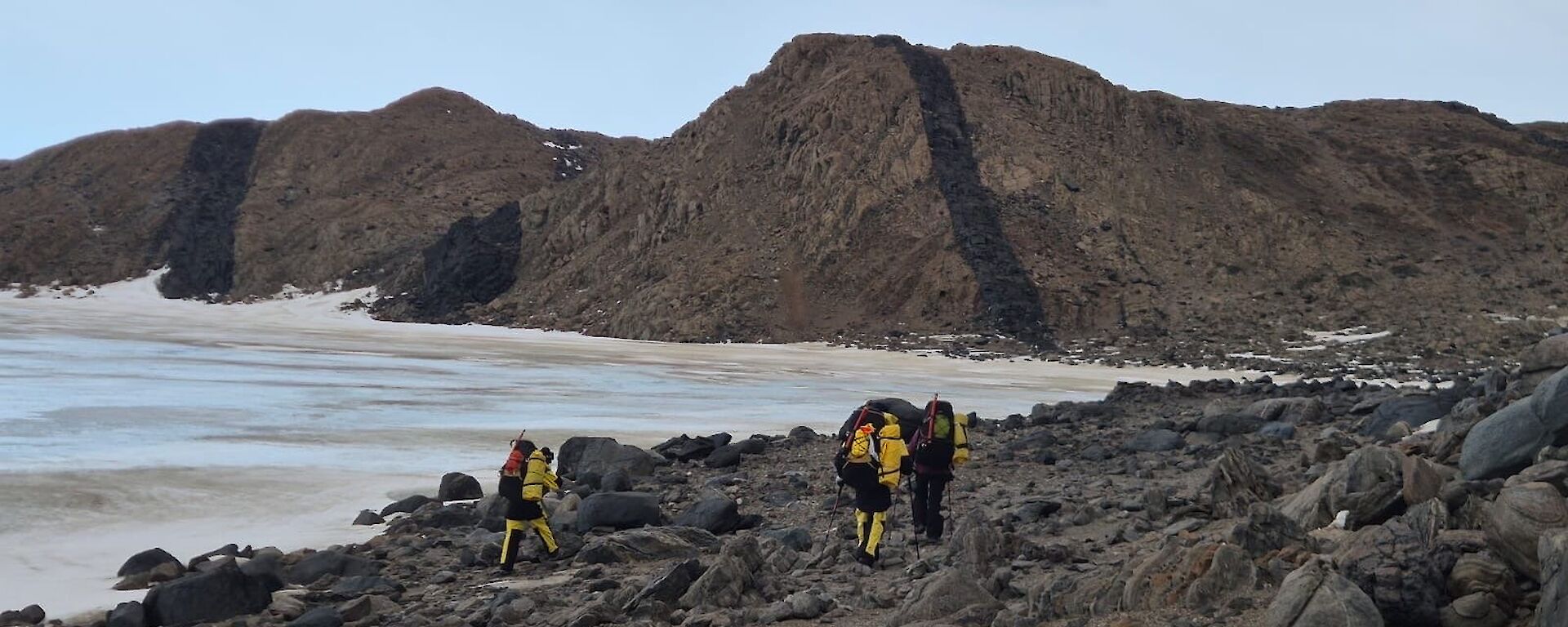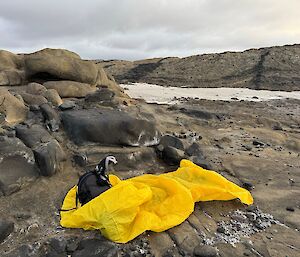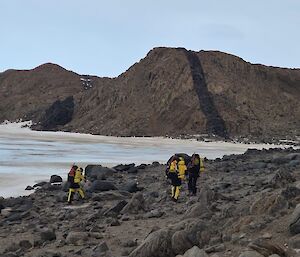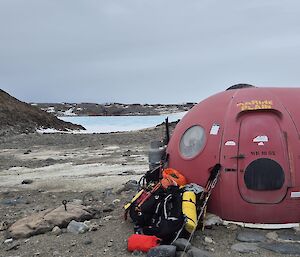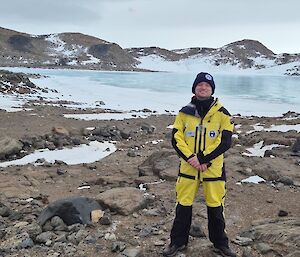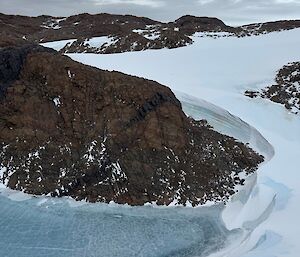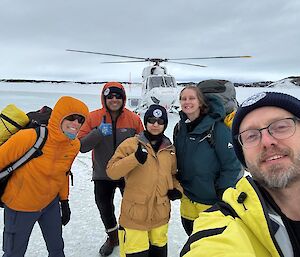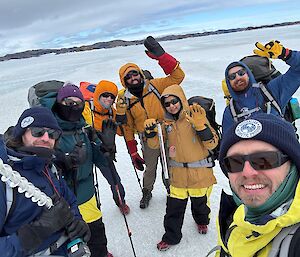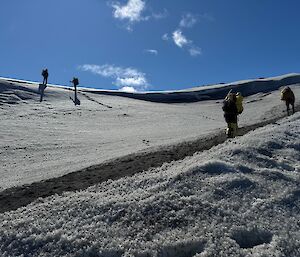A Tale of Two Bivvies
It was the calmest of times, it was the windiest of times.
As the 79th ANARE settles into their new home at Davis Station, a priority for the Field Training Officers is to get the new expeditioners survival trained. So far, three groups have headed out into the beautiful Vestfold Hills surrounding Davis to develop their navigation skills, better understand the hazards of the Antarctic environment, and yes, even sleep in a bivvy bag. As two meteorologists in separate groups soon learned, weather makes a huge difference to the bivvy experience. And thus, we present to you; A Tale of Two Bivvies.
Bivvy 1- PIETER CLAASSEN
As we reached Marine Plain Melon (not actually a melon sadly, rather, a melon shaped hut) after a long day of hiking, the wind started to pick up. Just as forecast, of course. Inside the melon, the howling was almost cosy, with the refuge offering protection from the piercing, dry, ice-cold Antarctic winds outside. But the comfort was short-lived – we would soon be left to fend for ourselves outside with only a bivvy bag for company. Now, for those who don't know, a bivvy (or bivouac) bag is a makeshift shelter that can be used in a pinch during hazardous conditions in the field, such as a blizzard. The bivvy bag is affectionately known as the 'chip packet' - with its small size and bright yellow colour, ours had an uncanny resemblance to an empty bag of Twisties, though unfortunately without any delicious cheesy crumbs within.
After a game of celebrity heads (essential for survival training), the time had come to leave the precious melon and find a place outside to call 'home' for the night. Shelter was sparse, terrain sloping and small floor-rocks ample, so finding a good place to set the bivvy loose was a challenge. My fellow intrepid expeditioners had smartly and swiftly already scooped up spots with at least a little protection from the wind, and all I could see left was a small, tombstone shaped rock left to 'shelter' behind. I christened the patch of dirt and rock behind it as 'home'. After many unsuccessful attempts at getting into the bivvy (it tended to turn into a large, unwieldy wind sock anytime it was opened slightly), I finally succeeded, plonking my bag on the floor to try to act as a counterweight to the incessant billowing caused by the wind.
Once inside, I was tired after a big day of surviving, so decided to try to get to sleep. The bivvy was a small, confined space, and the top of the bivvy lay close to my face. Anytime the wind picked up the gusts would send the bivvy bouncing up and down, gently slapping my face so rhythmically it might even be called relaxing by someone more zen and less claustrophobic than myself.
I decided the slapping just wasn't something I was into, so got to work propping the end of the bivvy up with my backpack to keep it off my face. The physics of the bivvy are a mysterious thing, and for whatever reason, when I propped my backpack behind me, the small airhole would turn and be blocked by the bag itself. Any time I tried to re-orient the bivvy, I would note another large rock beneath my sleeping mat. Not having the energy to get out and start again, it seemed I had a choice to make – a less than ideal supply of fresh air or incessant face slapping. I chose to forgo the face slapping.
With bivvy-off-face and eyemask on, I finally managed to drift off to sleep. I wonder what I'll dream of?
It's cold. I'm camping. It's bright outside. Someone is slapping me gently ... rat-a-tat-tat-tat-tat.
I wake up. My eye mask has come off, revealing the bright fluorescent yellow of the bivvy's interior. The bivvy is drooping again, and the face-slapping has recommenced. I prop it up again, and eventually fall back asleep.
Still cold. Now I'm sleeping outside for some reason. It's windy, and snow is falling on my face. Wait ... snow is falling on my face!?
I awaken with a startle. I notice that every time the wind blows, the frozen condensation on the inside of the bivvy falls off. Onto my face. Neat.
It's 5am now. I decide that's me done for the night, I pack away the bivvy and get ready for another beautiful hike through the Vestfolds, back to the comforts of Davis station.
That night, back on station, I climb into my warm and cosy bed and manage to fall asleep almost instantly. But the memory of the bivvy is still etched freshly in my mind.
Rat-a-tat-tat-tat-tat.
Bivvy 2 - STEVEN HADLEY
After descending to the frozen shore of Shirokaya Bay by helicopter, we put on our packs and boot spikes and went on foot, learning how to travel safely on the sea ice, using modern and time-tested navigating aids (maps, compass, GPS, sight) and practicing radio communication skills.
We rounded off the day in Brookes Hut with a cuppa and game of Monopoly Deal and then, as the polar evening drew out its long and heady last bow, headed out to the windless small hill where we would spend the twilight night.
Going to ground, our chosen sleeping patches varied from horizontal to slightly sloped, gravelly to rocky, damp to dry. I chose my abode for the lack of sharp rocks and pooling meltwater and that meant taking a higher position on the hill – but what if marauding skuas and sudden gusts of wind should intrude on my slumber?
As it was, the silence was golden, the air was still and clean. No birds heard. Barely a rustle of the fine yellow material of my bivvy bag could disturb my slump into deep and dreaming sleep. Periodically I woke through the night; a slight condensate mist drifted onto my sleeping bag from the roof of the bivvy; the cooling gravel beneath my warm, cosy chrysalis; the early end of the brief, dusky polar night. I darkened the bright yellow bivvy light with an eye mask as recommended by my fellow expeditioners.
Although we really lucked out with the calm weather, some slept better than others of course. I emerged last and bleary-eyed from my yellow chip packet. On our hike back to Davis we passed frozen and unfrozen lakes, rock and snow formations. It was a great opportunity to get to know my fellow expeditioners, travel by helicopter and camp and hike in the Vestfold Hills where Davis is situated. But the training also increased our individual and team resilience and improved our knowledge and capability to deal with the risks and challenges we face here.

